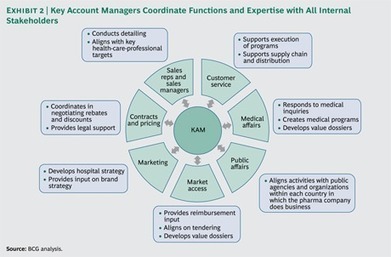Pharma companies must adapt to vast changes in health care by forming long-term strategic relationships founded on joint value creation with customers.
- Few pharma companies have revised their customer models in light of the vast changes in health care that are transforming customers.
- Effective key account management helps foster partnerships to create long-term mutual value and advantage.
- To get key account management right, pharma companies must gain a deep understanding of their customers, focus on join value creation, forge enduring partnerships, create cross-functional integration, and cultivate an entrepreneurial mindset.
Vast changes in the health care landscape worldwide are transforming customers. Treatment decision making is rapidly shifting from the individual physician to a diverse set of institutional customers, from hospitals to integrated care entities, and from payers to pharmacies and health-benefit-management companies. The pressure to deliver greater value is also driving this evolution. And while some customers are already more sophisticated than others, all are building experience and new capabilities to improve their economic performance and better manage patient outcomes.
The experience of hospitals offers a good example not only of how these market pressures are affecting institutions but also of the new ways in which institutional customers are responding to them. With health-care reimbursement levels shrinking, hospitals are consolidating, and they are building scale and expertise in the process. Most hospitals now employ a variety of analytical tools, such as benchmarks and studies, to evaluate price, cost effectiveness, and outcomes. They are also creating new positions in their management teams to bridge the traditionally segregated clinical and procurement domains. And they are launching or expanding efforts to assess medicines and procedures in their patient populations. Moreover, they are using the knowledge they gain through these efforts to improve formularies and treatment protocols.
The more sophisticated payers and integrated providers are also investing heavily in building capabilities. Increasingly, these customers are adopting a holistic approach to health care, partnering with pharmaceutical companies to improve outcomes, disease management, and compliance.
Despite these dramatic developments in the customer landscape, however, many pharma companies have yet to adapt their customer models. When key account management in the pharmaceutical industry is compared with that of other industries, including consumer goods and industrial products, it’s clear that most pharma companies are still lagging. Here’s why:
- Pharma companies don’t fully recognize the range of customers’ business drivers and needs. A one-size-fits-all-approach, even when designed for the most important customers, no longer works.
- Companies think transactionally instead of strategically. Pharma companies often put short-term concerns ahead of long-term considerations—for example, focusing on getting the highest possible price or the greatest revenues right away instead of weighing customers’ economic situations and evolving needs.
- Companies overcomplicate their customer management models. In an effort to keep pace with the growing complexities of customer requirements, pharma companies often end up tailoring individual customer relationships to an unsustainable degree. The result is reduced quality, unnecessary complexity, and inefficiencies that erode the profit potential of key accounts.
- Customer management is hampered by conflicting roles and responsibilities. Customer-facing functions, from account management and medical affairs to business units and support departments, often end up tripping all over each other—and the customer. The resulting redundancies and confusion can do more to erode value than to create it.
- Key account managers (KAMs) often lack the right competencies, and companies don’t seek or cultivate these skills. The best sales-line managers and sales representatives don’t necessarily make the best KAMs. Unfortunately, many pharma companies still struggle to recruite and promote people who have the skill sets that key account management requires. So far, few organizations have embedded the development of those skills in their hiring, training, and promotion processes.
Effective key account management, in our view, depends on cross-functional integration to deliver value. Many pharma companies do practice some form of key account management, but gaps exist in even the best-managed companies.
Via rob halkes



 Your new post is loading...
Your new post is loading...








Key Account Management is for pharma the most difficult service to develop! It needs an internal collaboration between siloed departments that one hasn't exercised for the last 10 to 20 years.
Yet, there's no way out outherwise than to give your customers the right attention to get partnerships. A partnership that goes further than just drug promotion and delivery...
BCG's vision about KAM. a dream?